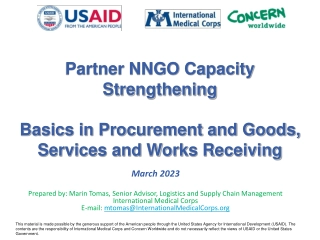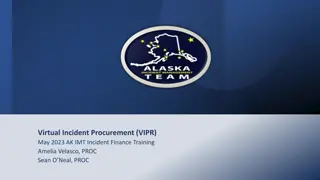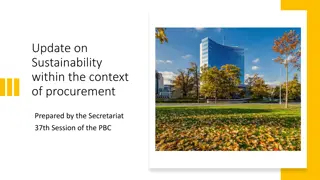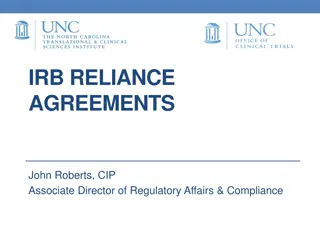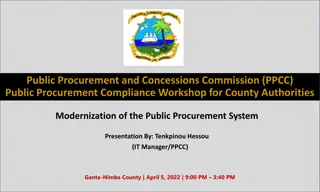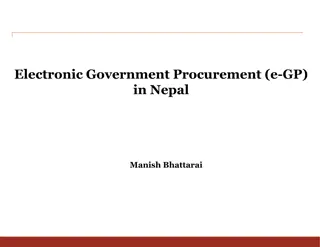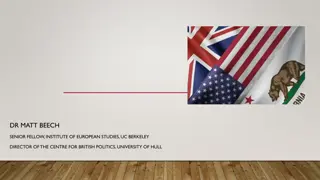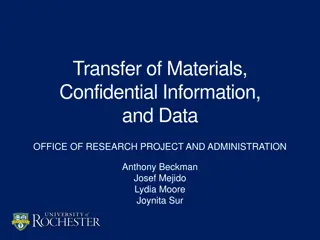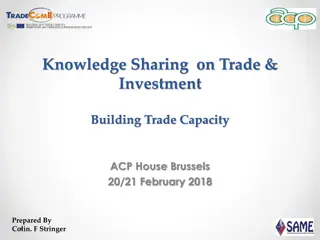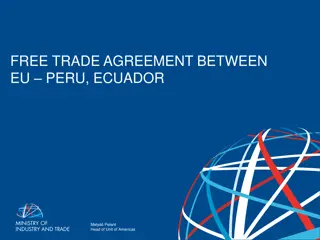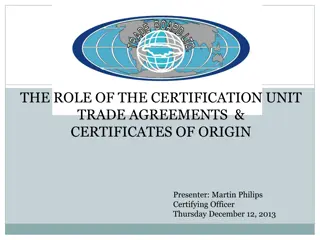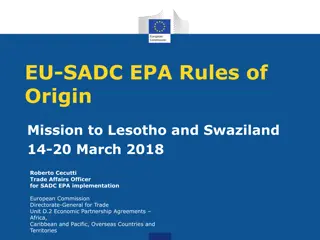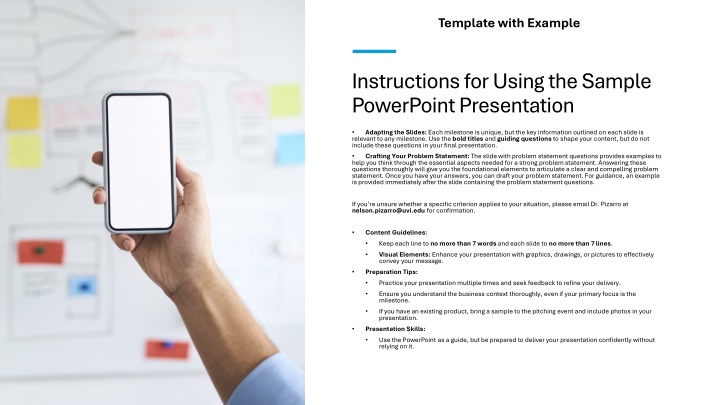
Trade Agreements Procurement Overview
The presentation outlines the impact of trade agreements on procurement in Ontario, highlighting covered entities, relevant agreements, and procurement commitments. It emphasizes the need for transparency, fairness, and compliance with trade agreements in public sector procurement.
Download Presentation

Please find below an Image/Link to download the presentation.
The content on the website is provided AS IS for your information and personal use only. It may not be sold, licensed, or shared on other websites without obtaining consent from the author. If you encounter any issues during the download, it is possible that the publisher has removed the file from their server.
You are allowed to download the files provided on this website for personal or commercial use, subject to the condition that they are used lawfully. All files are the property of their respective owners.
The content on the website is provided AS IS for your information and personal use only. It may not be sold, licensed, or shared on other websites without obtaining consent from the author.
E N D
Presentation Transcript
Template with Example Instructions for Using the Sample PowerPoint Presentation Adapting the Slides: Each milestone is unique, but the key information outlined on each slide is relevant to any milestone. Use the bold titles and guiding questions to shape your content, but do not include these questions in your final presentation. Crafting Your Problem Statement: The slide with problem statement questions provides examples to help you think through the essential aspects needed for a strong problem statement. Answering these questions thoroughly will give you the foundational elements to articulate a clear and compelling problem statement. Once you have your answers, you can draft your problem statement. For guidance, an example is provided immediately after the slide containing the problem statement questions. If you re unsure whether a specific criterion applies to your situation, please email Dr. Pizarro at nelson.pizarro@uvi.edu for confirmation. Content Guidelines: Keep each line to no more than 7 words and each slide to no more than 7 lines. Visual Elements: Enhance your presentation with graphics, drawings, or pictures to effectively convey your message. Preparation Tips: Practice your presentation multiple times and seek feedback to refine your delivery. Ensure you understand the business context thoroughly, even if your primary focus is the milestone. If you have an existing product, bring a sample to the pitching event and include photos in your presentation. Presentation Skills: Use the PowerPoint as a guide, but be prepared to deliver your presentation confidently without relying on it.
Milestone: From Idea to Prototype Nelson Pizarro email: nelson.pizarro@uvi.edu Phone: (111)111-1111 August 26, 2024
Problem Statement Problem Evidence: How do you know they're experiencing this problem? (e.g., "Survey data shows that 70% of commuters face delays due to unreliable public transport.") Problem Description: Clearly articulate the problem you're addressing. Customers: Who are they? (e.g., "Our primary customers are urban commuters aged 18-35.") Current Solutions: What are they currently doing to solve the problem? (e.g., "Most commuters rely on unpredictable ride-sharing apps.") Affected Customers: How many customers are affected? (e.g., "Approximately 2 million daily commuters in the city.") Solution Search Methods: How are they trying to find solutions? (e.g., "Through internet searches and mobile apps.") Current Solution Gaps: Why is the current solution not working? (e.g., "Existing solutions are costly and unreliable during peak hours.")
Our primary customers are urban commuters aged 18-35 who face significant challenges with unreliable public transportation. Survey data reveals that 70% of these commuters experience frequent delays, impacting their daily routines and productivity. Currently, approximately 2 million daily commuters in the city are affected by these issues, and many of them turn to unpredictable ride-sharing apps as a solution. Problem Statement However, these alternatives are not ideal, as they are often costly and unreliable, particularly during peak hours. Many commuters are actively seeking better solutions through internet searches and mobile apps, but existing options fail to meet their needs for affordability and consistency. This gap highlights a critical need for a more reliable and cost-effective solution to improve urban commuting experiences.
Solution Overview: Describe your innovative solution. (e.g., "A real-time commuter app that integrates all public and private transport options.") Value Proposition: How does your solution solve the problem effectively? (e.g., "Provides accurate, real-time updates and optimizes route planning.") Value Capture Strategy: How will you generate revenue or capture value from your solution? (e.g., Freemium model with in-app purchases for premium features) Solution and Value Capture Solution Overview: Our innovative solution is a real-time commuter app that integrates all public and private transport options, offering users a seamless and efficient way to navigate the city. Value Proposition: This app addresses the current commuting challenges by providing accurate, real-time updates and optimizing route planning to reduce delays and enhance the user experience. Value Capture Strategy: We plan to generate revenue through a freemium model, offering basic features for free while providing in-app purchases for premium features, such as advanced route customization and priority alerts.
Market: How do you confirm the need for this product or service? Customer surveys indicate a strong demand for eco-friendly packaging, with 85% of respondents willing to pay more for sustainable options. Is the competition minimal or manageable? Market analysis shows only two other companies offering similar products, both with limited regional presence Do you have the ability to produce this product or service? We have secured a reliable manufacturer with the capacity to produce 10,000 units per month, ensuring a steady supply chain for our product launch What is the shortest startup time for this product or service? With established supplier agreements and streamlined production processes, we can launch the product within three months Market Feasibility Confirmation of Need: Customer surveys indicate a strong demand for eco-friendly packaging, with 85% of respondents willing to pay more for sustainable options. Competition: Market analysis shows only two other companies offering similar products, both with limited regional presence. Production Capability: We have secured a reliable manufacturer with the capacity to produce 10,000 units per month, ensuring a steady supply chain for our product launch. Startup Timeline: With established supplier agreements and streamlined production processes, we can launch the product within three months.
Product: 1. Is the produce or service feasible? The product uses readily available materials and proven technology, allowing for a low-cost, quick production setup with minimal regulatory hurdles. Is the technology existing or achievable? there is existing or achievable technology: The software leverages existing cloud-based technology, ensuring scalability and integration with current systems. What is the lowest possible start-up cost? By using a drop-shipping model and digital marketing, we can minimize initial costs to under $5,000. What are the major circumstantial obstacles, if any (e.g., legal, environmental, materials)? There are no legal barriers or regulatory restrictions for launching this service in our target market. 2. 3. 4. Product Feasibility Feasibility: The product uses readily available materials and proven technology, allowing for a low-cost, quick production setup with minimal regulatory hurdles. Technology Availability: The software leverages existing cloud-based technology, ensuring scalability and integration with current systems. Startup Cost: By using a drop-shipping model and digital marketing, we can minimize initial costs to under $5,000. Circumstantial Obstacles: There are no legal barriers or regulatory restrictions for launching this service in our target market.
Milestone Goal: What specific milestone do you hope to achieve? (e.g., "Developing a working prototype of the app.") Milestone Description Milestone Justification: How will achieving this milestone advance your entrepreneurial journey? (e.g., "The prototype will allow us to gather user feedback and validate core functionalities before a full-scale launch.")
Total Funding Needed: Specify the amount. (e.g., "$5,000") Budget Breakdown: Prototype Development: $3,000 (software development and testing) Budget Request User Testing: $1,000 (incentives for participants) Market Analysis: $1,000 (data purchase and analysis Budget Justification: Why is each cost necessary? (e.g., "Funds will ensure a functional prototype that meets user needs and validates market potential.")
Identified Risks: List potential risks. (e.g., "Technical issues with prototype development; market size may be smaller than anticipated.") Risk and Mitigation Mitigation Strategies: How will you address these risks? (e.g., "Conduct preliminary user testing with wireframes to identify technical issues early; perform a detailed market analysis to better understand market potential.")
Summary: Recap the problem, solution, and the importance of the milestone. Conclusion Call to Action: Encourage feedback or support (if applicable).
Thank You Slide Open the floor for questions and further discussion.
Additional Resources (Optional) References: Cite any data sources or research used. Contact Information: Provide your email or other contact details for follow-up questions.

